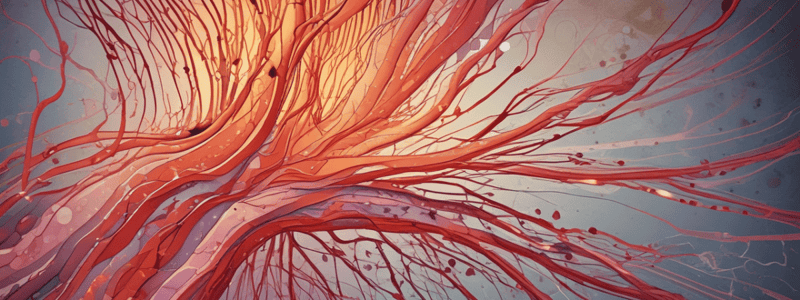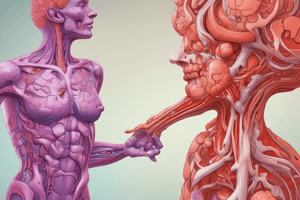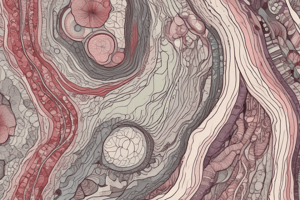Podcast
Questions and Answers
What is the outcome of acute inflammation in which the site of inflammation is replaced by connective tissue?
What is the outcome of acute inflammation in which the site of inflammation is replaced by connective tissue?
- Abscess formation
- Healing by connective tissue replacement (fibrosis) and scaring (correct)
- Complete Resolution
- Progression to chronic inflammation
What is the most common cause of chronic inflammation?
What is the most common cause of chronic inflammation?
- Recurrent attacks of acute inflammation
- Prolonged exposure to toxic agents
- Hypersensitivity diseases/ Immune mediated inflammatory diseases
- Persistent Infection (correct)
What type of cells are involved in the defense against helminthic parasites and allergic inflammation?
What type of cells are involved in the defense against helminthic parasites and allergic inflammation?
- TH1 cells
- TH2 cells (correct)
- TH17 cells
- Macrophages
What is the term for the process by which new vessels proliferate in chronic inflammation?
What is the term for the process by which new vessels proliferate in chronic inflammation?
What is the main difference between acute and chronic inflammation in terms of cell type?
What is the main difference between acute and chronic inflammation in terms of cell type?
What is the term for the local defect or excavation of the surface of an organ or tissue?
What is the term for the local defect or excavation of the surface of an organ or tissue?
What is the term for the process by which inflammatory cells induce tissue destruction?
What is the term for the process by which inflammatory cells induce tissue destruction?
What type of cells are involved in the defense against many bacteria and viruses?
What type of cells are involved in the defense against many bacteria and viruses?
What is the term for the chronic inflammation of prolonged duration?
What is the term for the chronic inflammation of prolonged duration?
What type of cells are involved in the secretion of antibodies?
What type of cells are involved in the secretion of antibodies?
What is the primary function of eosinophils in the body?
What is the primary function of eosinophils in the body?
What is the role of mast cells in the body?
What is the role of mast cells in the body?
What is the characteristic feature of granulomatous inflammation?
What is the characteristic feature of granulomatous inflammation?
What is the purpose of granuloma formation?
What is the purpose of granuloma formation?
What type of granuloma lacks central necrosis?
What type of granuloma lacks central necrosis?
What is the composition of a typical granuloma?
What is the composition of a typical granuloma?
What is the term for the collective systemic effects of inflammation?
What is the term for the collective systemic effects of inflammation?
Which cytokines are the most important mediators of acute phase reaction?
Which cytokines are the most important mediators of acute phase reaction?
What are the five local signs of inflammation?
What are the five local signs of inflammation?
Who added the fifth sign of inflammation, functio laesen (loss of function)?
Who added the fifth sign of inflammation, functio laesen (loss of function)?
What is the characteristic of serous inflammation?
What is the characteristic of serous inflammation?
What is the term for the accumulation of fluid in serous cavities?
What is the term for the accumulation of fluid in serous cavities?
What is the main difference between fibrinous inflammation and serous inflammation?
What is the main difference between fibrinous inflammation and serous inflammation?
What is the consequence of suppurative inflammation?
What is the consequence of suppurative inflammation?
What is the composition of purulent exudate?
What is the composition of purulent exudate?
What is the example of fibrinous inflammation?
What is the example of fibrinous inflammation?
What is the characteristic of chronic inflammation?
What is the characteristic of chronic inflammation?
What is the term for the localized collection of purulent inflammatory exudate or pus?
What is the term for the localized collection of purulent inflammatory exudate or pus?
What is the cause of purulent inflammation with abscess formation?
What is the cause of purulent inflammation with abscess formation?
What is the name of the image that shows the epidermis separated from the dermis by a focal collection of serous effusion?
What is the name of the image that shows the epidermis separated from the dermis by a focal collection of serous effusion?
What is the primary source of cytokines produced in response to infectious agents or immunologic reactions?
What is the primary source of cytokines produced in response to infectious agents or immunologic reactions?
What is the primary function of cytokines in the context of fever?
What is the primary function of cytokines in the context of fever?
Which of the following acute phase proteins is synthesized in response to IL-6?
Which of the following acute phase proteins is synthesized in response to IL-6?
What is the primary reason for the increased erythrocyte sedimentation rate (ESR) in inflammatory disorders?
What is the primary reason for the increased erythrocyte sedimentation rate (ESR) in inflammatory disorders?
What is the most common feature of inflammatory reactions, especially those induced by bacterial infection?
What is the most common feature of inflammatory reactions, especially those induced by bacterial infection?
Which of the following infections is characterized by leukopenia?
Which of the following infections is characterized by leukopenia?
What is the primary cause of decreased sweating in inflammatory reactions?
What is the primary cause of decreased sweating in inflammatory reactions?
What is the clinical triad described as septic shock?
What is the clinical triad described as septic shock?
Which of the following cytokines is involved in the pathogenesis of septic shock?
Which of the following cytokines is involved in the pathogenesis of septic shock?
What is the primary function of elevated plasma levels of C-Reactive protein (CRP) in the context of atherosclerosis?
What is the primary function of elevated plasma levels of C-Reactive protein (CRP) in the context of atherosclerosis?
Study Notes
Morphological Patterns of Acute Inflammation
- Serous inflammation: characterized by outpouring of a thin fluid derived from plasma or mesothelial cells, leading to accumulation of fluid in serous cavities (e.g., skin blisters)
- Fibrinous inflammation: characterized by deposition of fibrin in extracellular spaces, occurring in cases of more severe injuries with greater vascular permeability (e.g., fibrinous exudate in meninges, pericardium, and pleura)
- Purulent inflammation: characterized by production of large amounts of pus (purulent exudate), consisting of neutrophils, liquefactive necrosis, and edema fluid (e.g., caused by pyogenic bacteria like staphylococci)
- Ulcer: a local defect or excavation of the surface of an organ or tissue, produced by sloughing of inflammatory necrotic tissue (e.g., mucosa of the mouth, stomach, intestines, genitourinary tract, skin, and subcutaneous tissues)
Outcome of Acute Inflammation
- Complete resolution, with regeneration of native cells and restoration of the site of acute inflammation to normal
- Abscess formation, particularly in infections with pyogenic organisms
- Healing by connective tissue replacement (fibrosis) and scarring, occurring after substantial tissue destruction, when the inflammation occurs in tissues that do not regenerate or when there is abundant fibrin exudation
- Progression to chronic inflammation
Chronic Inflammation
- Defined as inflammation of prolonged duration (weeks to years), characterized by continuing inflammation, tissue injury, and healing, often by fibrosis
- Causes: persistent infection, prolonged exposure to toxic agents, hypersensitivity diseases, and chronic inflammation following acute inflammation
- Morphologic features: infiltration with mononuclear cells (macrophages, lymphocytes, and plasma cells), tissue destruction or necrosis, and attempts at healing (repair) by connective tissue replacement of damaged tissue
Cells in Chronic Inflammation
- Macrophages: major drivers of inflammation in autoimmune and chronic inflammatory diseases
- Lymphocytes: B lymphocytes activate and develop into plasma cells, secreting antibodies; T lymphocytes secrete cytokines, promoting inflammation and influencing the nature of the inflammatory reaction
- Eosinophils: abundant in immune reactions mediated by IgE and parasitic infections, recruited by eotaxin
- Mast cells (basophils): participate in both acute and chronic inflammation, express surface receptors that bind to the Fc portion of IgE, and degranulate, releasing histamines
Granulomatous Inflammation
- A distinctive pattern of chronic inflammation, characterized by granuloma formation
- Granuloma: a collection of epithelioid histiocytes (macrophages with abundant pink cytoplasm), usually surrounded by giant cells and a rim of lymphocytes
- Formation of a granuloma effectively "walls off" the offending agent and is a useful defense mechanism
- Causes: foreign body granulomas, immune granulomas, and granulomatous inflammation in response to poorly degradable antigens
Systemic Effects of Inflammation
- Acute phase reaction or systemic inflammatory response syndrome
- Cytokines (TNF-α, IL-1, and IL-6) are the most important mediators of the acute phase reaction
- Clinical and pathologic changes:
- Fever (elevation of body temperature)
- Elevated plasma levels of acute-phase proteins (CRP, fibrinogen, and SAA protein)
- Leukocytosis (elevation of total white blood cell count)
- Leukopenia (decrease in total white blood cell count)
- Other manifestations (increased heart rate and blood pressure, decreased sweating, rigors, chills, anorexia, somnolence, and malaise)
- Septic shock (in severe bacterial infections)
Studying That Suits You
Use AI to generate personalized quizzes and flashcards to suit your learning preferences.
Description
Learn about the morphological patterns of acute and chronic inflammation, including serous, fibrinous, and purulent inflammation, and their systemic effects.




